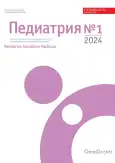Features of the voice apparatus in children with hearing loss
- 作者: Daldova V.S.1, Merkulova E.P.2, Eremenko J.E.1, Bosiakov S.M.3, Vasenkova E.I.3
-
隶属关系:
- Republican Scientific and Practical Center for Otorhinolaryngology
- Belarusian State Medical University
- Belarusian State University
- 期: 编号 1 (2024)
- 页面: 33-36
- 栏目: Articles
- URL: https://pediatria.orscience.ru/2658-6630/article/view/633326
- DOI: https://doi.org/10.26442/26586630.2024.1.202771
- ID: 633326
如何引用文章
全文:
详细
Background. One of the critical and urgent problems of pediatric otorhinolaryngology is impaired hearing, which is considered both medical and social. In the absence of auditory feedback, children with hearing impairment suffer from voice and speech disorders due to their inability to control their voice.
Aim. To determine the nature of vocal apparatus (VA) disorders in children with bilateral chronic sensorineural hearing loss.
Materials and methods. A subjective and objective voice assessment was conducted in 100 children aged 4-12 years with varying severity of bilateral chronic sensorineural hearing loss.
Results. The study found that hearing impairment is associated with VA disorders in children with severe hearing loss (HL), reflected in their voice's acoustic characteristics. The medical care for children with grade 3-4 HL should not be limited to hearing aids; measures to identify and treat HA abnormalities are also necessary. Phonopedic classes are indicated for children with any HL since most of them (72.9%) have a change in the timbre and modulation of the voice, which can aggravate inevitable communication problems.
全文:
作者简介
Valeryia Daldova
Republican Scientific and Practical Center for Otorhinolaryngology
编辑信件的主要联系方式.
Email: lera.doldova@mail.ru
ORCID iD: 0009-0007-7051-6706
otorhinolaryngologist-phoniatrist
白俄罗斯, MinskElena Merkulova
Belarusian State Medical University
Email: lera.doldova@mail.ru
ORCID iD: 0000-0002-6533-3696
Sci. (Med.), Belarusian State Medical University
白俄罗斯, MinskJulia Eremenko
Republican Scientific and Practical Center for Otorhinolaryngology
Email: lera.doldova@mail.ru
ORCID iD: 0000-0003-2524-1145
Sci. (Med.), Prof.
俄罗斯联邦, MinskSergei Bosiakov
Belarusian State University
Email: lera.doldova@mail.ru
ORCID iD: 0000-0003-4524-9304
Sci. (Phys.-Math.), Belarusian State University
白俄罗斯, MinskElena Vasenkova
Belarusian State University
Email: lera.doldova@mail.ru
ORCID iD: 0000-0002-3464-0220
Cand. Sci. (Phys.-Math.), Belarusian State University
白俄罗斯, Minsk参考
- Natalizia A, Casale M, Guglielmelli E, et al. An overview of hearing impairment in older adults: perspectives for rehabilitation with hearing aids. Eur Rev Med Pharmacol Sci. 2010;14(3):223-9.
- De Boodt F, Van der Veken P, Esertepe S, Mensels M. Hearing prevention experience. B-ENT. 2016;Suppl. 26(2):167-76.
- Upadhyay M, Datta R, Nilakantan A, et al. Voice Quality in Cochlear Implant Recipients: An Observational Cross Sectional Study. Indian J Otolaryngol Head Neck Surg. 2019;71(Suppl. 2):1626-32. doi: 10.1007/s12070-019-01700-3
- Flaherty MM, Browning J, Buss E, Leibold LJ. Effects of Hearing Loss on School-Aged Children’s Ability to Benefit From F0 Differences Between Target and Masker Speech. Ear Hear. 2021;42(4):1084-96. doi: 10.1097/AUD.0000000000000979
- Куренева Е.Ю., Шидловская Т.А. Количественная оценка состояния различных отделов слухового анализатора при хронической функциональной гипотонусной дисфонии в зависимости от характера ее течения. Российская оториноларингология. 2004;1(8):66-9 [Kureneva EYu, Shidlovskaya TA. Quantitative assessment of the state of various departments of the auditory analyzer in chronic functional hypotonic dysphonia, depending on the nature of its course. Russian Otorhinolaryngology. 2004;1(8):66-9 (in Russian)].
- Вартанян И.А., Черниговская Т.В. Вокализационная и речевая системы мозга: эволюционно-нейробиологический анализ. Журнал эволюционной биохимии и физиологии. 1990;6:826-36 [Vartanian IA, Chernigovskaia TV. Vokalizatsionnaia i rechevaia sistemy mozga: evoliutsionno-neirobiologicheskii analiz. Zhurnal Evoliutsionnoi Biokhimii i Fiziologii. 1990;6:826-36 (in Russian)].
- Coelho AC, Brasolotto AG, Bevilacqua MC. Systematic analysis of the benefits of cochlear implants on voice production. J Soc Bras Fonoaudiol. 2012;24(4):395-402. doi: 10.1590/s2179-64912012000400018
- Cohen SM, Turley R. Coprevalence and impact of dysphonia and hearing loss in the elderly. Laryngoscope. 2009;119(9):1870-3. doi: 10.1002/lary.20590
- Selleck MA, Sataloff RT. The impact of the auditory system on phonation: a review. J Voice. 2014;28(6):688-93. doi: 10.1016/j.jvoice.2014.03.018
- Yoshinaga-Itano C. From Screening to Early Identification and Intervention: Discovering Predictors to Successful Outcomes for Children With Significant Hearing Loss. J Deaf Stud Deaf Educ. 2003;8(1):11-30. doi: 10.1093/deafed/8.1.11
- Netten AP, Rieffe C, Theunissen SC, et al. Low empathy in deaf and hard of hearing (pre)adolescents compared to normal hearing controls. PLoS One. 2015;10(4):e0124102. doi: 10.1371/journal.pone.0124102
- Fellinger J, Holzinger D, van Dijk J. Deaf blindness – hearing and vision handicap. Kinderkrankenschwester. 2012;31(1):20-3 (in German).
- Francis DO, Daniero JJ, Hovis KL, et al. Voice-Related Patient-Reported Outcome Measures: A Systematic Review of Instrument Development and Validation. J Speech Lang Hear Res. 2017;60(1):62-88. doi: 10.1044/2016_JSLHR-S-16-0022
- Gautam A, Naples JG, Eliades SJ. Control of speech and voice in cochlear implant patients. Laryngoscope. 2019;129(9):2158-63. doi: 10.1002/lary.27787
补充文件








